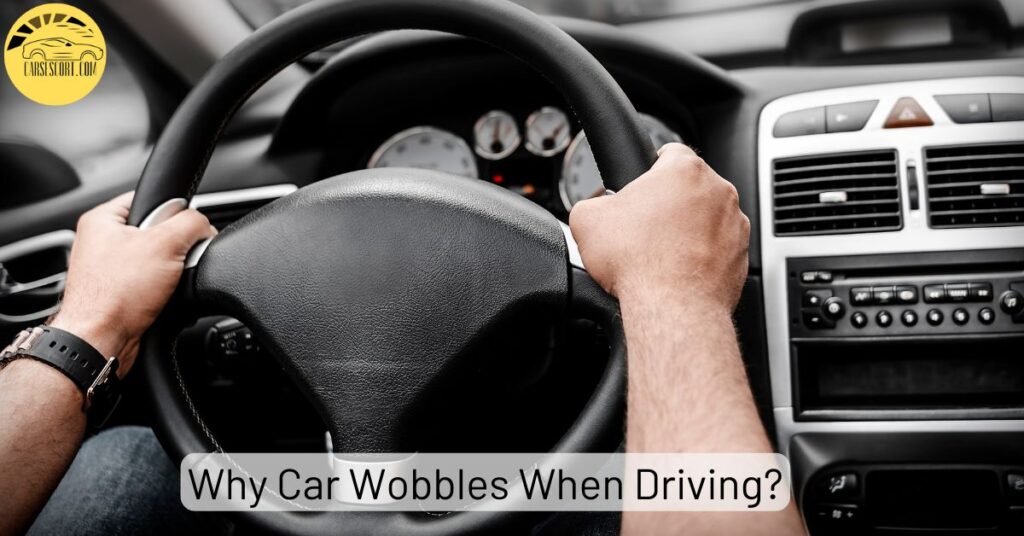If you’ve ever experienced the unsettling sensation of your car wobbling while driving, you know it can be both alarming and frustrating. Not only does it make for an uncomfortable ride, but it can also be a safety concern if left unaddressed. Several reasons can make your car wobble, from simple issues like tire imbalance to more severe problems with your suspension or steering system.
The most common cause of car wobbles is an issue with your tires. Poor wheel alignment, improper tire balance, uneven tire wear, loose or damaged wheel components, separated tire tread, out-of-round tires, or low tire pressure can make your car wobble while driving.
However, other reasons can also make your vehicle shake and vibrate, ranging from minor issues to more serious problems that require immediate attention.
This blog post is an ultimate guide. Continue reading to learn about all the possible causes and their fixes.
Why Car Wobbles When Driving?
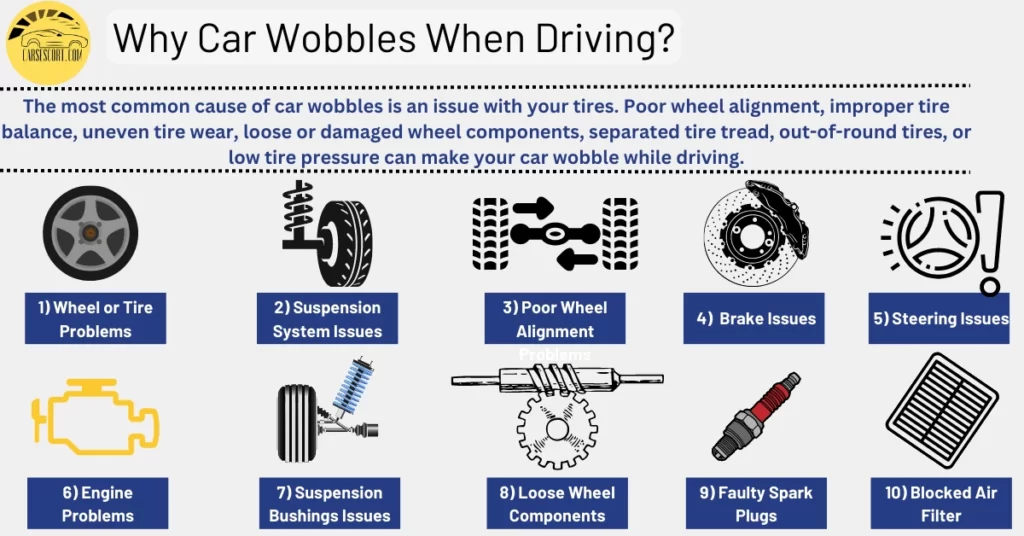
1) Wheel or Tire Problems
Tire problems are one of the most common reasons for car wobbling when driving. Several tire-related issues can cause a car to wobble, including:
- Over time, tires will wear out due to everyday use, and this wear can cause the car to wobble. If the tread on the tires is too worn, it can cause them to lose grip on the road, leading to instability and vibrations.
- If the tires are not rotated, balanced regularly or bent wheel, they may wear unevenly, which can cause the car to vibrate. Uneven wear can also be caused by poor wheel alignment or worn suspension components.
- A damaged tire, such as one with a puncture or a sidewall bulge, can cause the car to wobble. Driving on a damaged tire can also be dangerous, as it can lead to a blowout or other tire failure.
- If the tires are not inflated to the proper pressure, it can cause shaking. Overinflated or underinflated tires can also wear unevenly, leading to additional issues.
- If the tires are not adequately balanced, it can make you wobble while driving because an unbalanced tire will not rotate smoothly, causing vibrations that can be felt throughout the vehicle.
Tire issues are very serious safety issue. To prevent tire-related issues, it’s essential to perform regular maintenance on your car’s tires.
Including regularly checking the tire pressure and ensuring that the tires are properly inflated, rotating the tires to ensure even wear, and having the tires balanced and aligned as needed.
If you notice any signs of tire damage, such as punctures, bulges, or uneven wear, it’s vital to have them inspected and replaced new tires as necessary to prevent further issues.
2) Suspension System Issues
The suspension system in a vehicle plays a crucial role in maintaining stability and comfort while driving. The vehicle suspension system absorbs shocks and vibrations from the road and ensures the car stays balanced and level.
However, if any part of the suspension system is damaged or worn out, it can lead the vehicle to wobble while driving. Some of the most common suspension issues that can cause a car to wobble include:
- The shocks absorbers are responsible for absorbing shocks and vibrations from the road. If worn out, they may be unable to do their job correctly.
- Struts are similar to shocks but are a more integral part of the suspension system. If worn out, they can lead to uneven shaking and may even affect the vehicle’s steering.
- The springs support the car’s weight and absorb shocks from the road. If worn out, they may not be able to provide enough support, and your car wobbles when driving.
- Any part of the suspension system, such as the control arms, ball joints, or tie rods, can become damaged over time. They can cause wobbling and affect the vehicle’s steering if not repaired or replaced.
- If one corner of the vehicle sits lower than the others, it can cause to vibrate due to worn-out springs or a damaged suspension component.
To prevent suspension issues, it is essential to have the suspension system inspected regularly by a qualified mechanic.
A professional mechanic will help identity worn or damaged components and replace them before they cause problems.
3) Poor Wheel Alignment Problems
Wheel alignment is an important aspect of car maintenance that helps ensure all four wheels point in the same direction.
Proper alignment is important for several reasons, including ensuring that the tires wear evenly and reducing the amount of rolling resistance, which can improve fuel efficiency.
However, if the wheel alignment is off, your vehicle may pull to one side, wobble or vibrate.
Following are some of the most common issues that can occur due to bad tire alignment:
- If the separated tires of your vehicle are not aligned properly, the tires will not wear evenly, leading to tires wearing out faster than usual and causing poor alignment and a wobbling sensation while driving slow, fast or same speed.
- Improper alignment can cause the steering to pull to one side, making it more challenging to steer the car straight.
- Good wheel alignment ensures that all four wheels point in the same direction. If the alignment is poor, it compels the car to pull to one side or vibrate.
To prevent alignment-related issues, it is essential to have the wheel alignment checked regularly, especially after hitting a curb or pothole.
Most vehicle manufacturers recommend checking the alignment every 10,000 miles or once or twice a year.
If you observe these signs, you must check the alignment immediately to prevent further damage to the tires and suspension system.
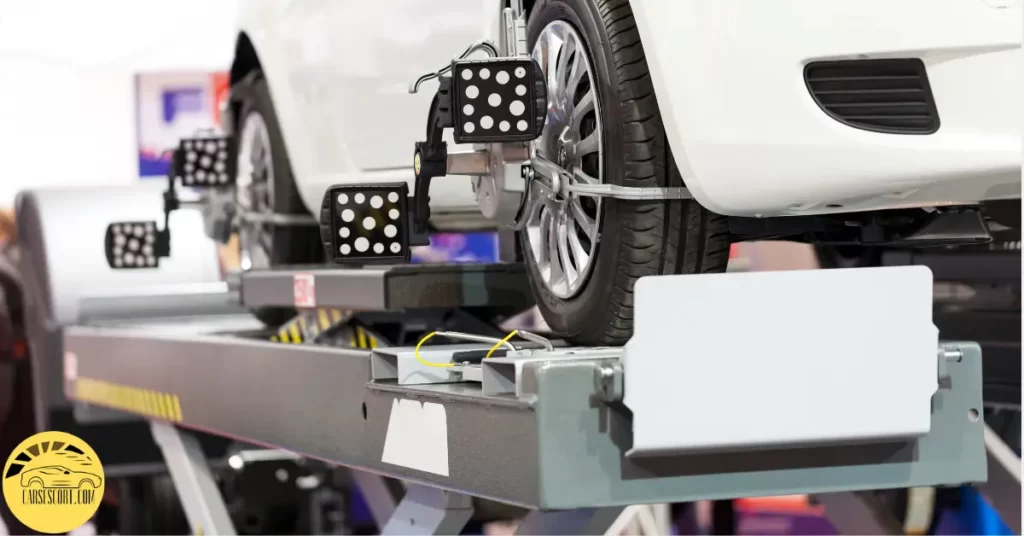
4) Brake Issues
Brakes are an essential component of a car’s safety system, and any issues with the brakes can cause serious safety concerns. If the brakes are worn out, or there is a problem with the brake system, it can cause the car to wobble when braking.
Following are some of the most common brake-related issues that can cause vehicle wobbles:
- When your vehicle’s brake pads grip the rotor, it creates friction that slows down the car. Over time, the rotors can become warped, which can cause the car to wobble when braking.
- If the brake pads are worn out, they may not grip the rotors properly, causing the car wobbles when driving.
- If the calipers are sticking, they may not release the brake pads properly, causing the car to vibrate when braking.
- If there is an issue with the braking system, such as a leak in the brake lines or a malfunctioning master cylinder, it can cause the vehicle to wobble when braking.
To prevent brake-related issues, it is vital to have the brakes inspected regularly by a qualified mechanic. They can check the brake pads, rotors, calipers, and brake system for any signs of wear or damage.
Having the brakes serviced regularly is essential, including flushing the brake fluid and repairing and replacing the brake pads.
5) Steering Issues
The steering system is an essential component of a vehicle responsible for controlling the direction and movement of the vehicle. If there is a problem with the car steering system, it can cause the car to wobble while driving.
Here are some of the most common steering-related issues that can cause wobbling:
- If the steering rack is worn out or damaged, the car can shake while driving.
- If the tie rods are loose or damaged, it can cause the wheels to vibrate while driving.
- If the steering linkage is damaged or worn out, it can cause the wheels to wobble or shake while driving.
- A problem with the steering column, such as a loose connection or a damaged bearing, can cause the car to wobble or shake while driving.
To prevent steering-related issues, it is essential to have the steering system checked regularly by a qualified mechanic. They can inspect the steering rack, tie rods, steering linkage, and steering column for any signs of wear or damage.
It is important to have the steering system serviced regularly, which can include flushing the power steering fluid and checking the alignment of the steering system.
6) Engine Problems
While rare, engine problems can cause a car to wobble. The engine generates power and provides the necessary energy to move the car.
Some engine issues can lead to vibrate excessively, creating a wobbling sensation. Here are some of the most common engine-related issues that can cause wobbling:
- If the engine mounts are worn out or damaged, it can cause the engine to vibrate excessively and create a wobbling sensation.
- A misfiring engine occurs when one or more cylinders fail to ignite appropriately, causing the engine to vibrate and create a shaking sensation.
- If there is low engine compression, it can cause the engine and vehicle to vibrate.
- A clogged fuel filter or a malfunctioning fuel pump can cause the engine to vibrate and create a wobbling sensation.
To prevent engine-related issues, it is essential to have the engine checked regularly by a qualified mechanic. They can inspect the engine mounts, cylinders, and fuel system for any signs of wear or damage.
If any issues are identified, they can be repaired or replaced before they cause safety concerns. It is vital to have the engine serviced regularly, including changing the oil and checking the spark plugs.
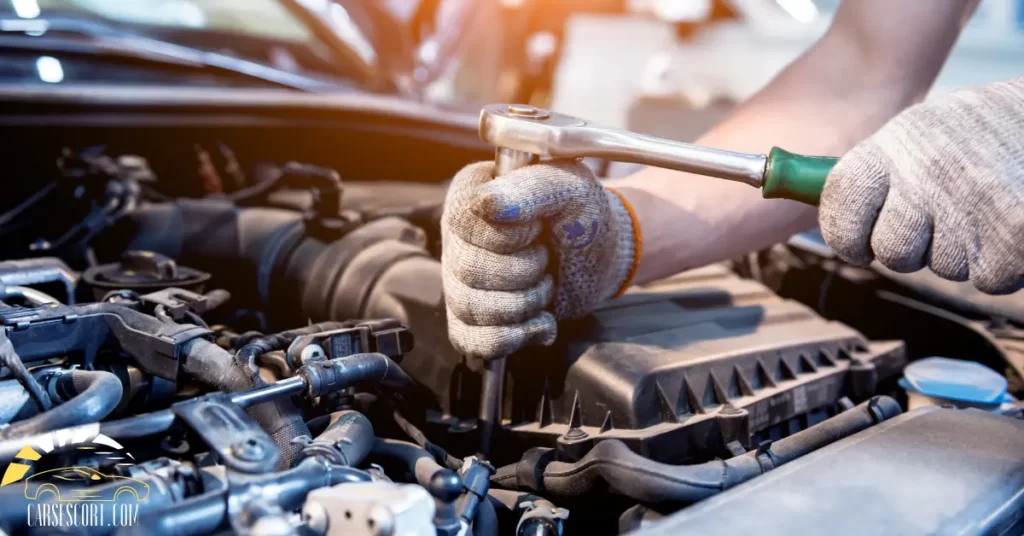
7) Suspension Bushings Issues
Suspension bushings are an integral part of a car’s suspension system, connecting the suspension components to the car’s frame.
The bushings are typically rubber or polyurethane and are designed to absorb shocks and vibrations while driving. However, these bushings can wear out over time, causing wobble.
Here’s how worn suspension bushings can cause a wobbling sensation:
- Worn suspension bushings can cause the car’s suspension system to become misaligned, leading to uneven tire wear and making the car wobble and shake, especially at high speeds.
- Worn suspension bushings can also cause the suspension components to become loose or damaged and cause a wobbling sensation, as the suspension system can no longer effectively absorb shocks and vibrations.
- If the bushings wear out, the car wobbles when driving and may experience increased body roll, leading to a vibrating sensation.
To prevent issues with suspension bushings, it is essential to have the suspension system checked regularly by a qualified mechanic. They can inspect the bushings for any wear or damage and replace them if necessary.
It is also essential to have the suspension system serviced regularly, including replacing worn components and aligning the wheels.
8) Loose or Damaged Wheel Components
Loose or damaged wheel components can cause the car to wobble, affecting the wheels’ stability and balance. Here are some examples of how loose or damaged wheel components can cause the vehicle to wobble:
- If the lug nuts are damaged, not tightened properly, or become loose over time, it can cause the wheel to wobble.
- If the wheel bearings become worn or damaged, it can cause the wheels to move unevenly and shake.
- If the hub assembly becomes damaged or worn, it can cause the wheel to wobble and vibrate.
Loose or damaged wheel components can be dangerous, as they can cause the wheel to come loose while driving. If you notice any wobbling or shaking while driving, it is crucial to have your car inspected by a qualified mechanic.
They can check the lug nuts, wheel bearings, and hub assembly for any signs of wear or damage and replace them if necessary. Regular maintenance, such as rotating the wheels and checking the lug nuts, can also help prevent issues with loose or damaged wheel components.
9) Faulty Spark Plugs
Spark plugs can become fouled or worn out after prolonged use, affecting the engine’s performance and causing it to misfire.
If the spark plugs are faulty, it can cause the engine to misfire, which can create a wobbling sensation while driving. A misfire occurs when the spark plug fails to ignite the fuel in the cylinder at the right time, causing the engine to run rough or shake.
Faulty spark plugs can also lead to a loss of power, increased emissions, and decreased fuel efficiency.
- If the spark plug gap is too small or too large, it can affect the plug’s performance and cause the engine to misfire.
- If there is oil or carbon buildup on the spark plug, it can affect the spark and cause the engine to misfire.
- If the spark plug is not in the correct heat range for the engine, it can cause the engine to misfire.
If you notice any wobbling or shaking while driving, it is crucial to have your car inspected by a qualified mechanic. They can check the spark plugs for any wear or damage and may replace them if necessary.
Regular maintenance, such as replacing the spark plugs at the recommended interval and using the correct spark plug , can also help prevent issues with faulty spark plugs.
10) Blocked Air Filter
The air filter of the car work is a shield for the engine and prevent dirt, debris, carbon, and other contaminants from entering the engine’s combustion chamber.
- After prolonged use, these filters can become clogged with dirt and debris, restricting the airflow to the engine and affecting its performance.
- A blocked air filter can cause the engine to run poorly, creating a wobbling sensation while driving.
- The engine may also experience decreased power, fuel efficiency, and increased emissions.
- A blocked air filter can cause the engine to stall or fail to start altogether.
- In some cases, a blocked air filter can cause damage to the engine over time.
As the air filter becomes more clogged, the engine is forced to work harder to draw in air, which can cause increased wear and tear on the engine components.
To prevent issues with a blocked air filter, replacing it at the recommended interval, typically every 12,000 to 15,000 miles, is essential. The air filter should be replaced more frequently when needed.
You May Also Like To Read:
Why Does It Feel Like My Tire Is Wobbling At Low Speed?
If you feel like your tire is wobbling at low speeds, there could be wheel alignment issues, worn or damaged tires, suspension problems, brake problems, or loose or damaged wheel components.
Having a mechanic check out the issue as soon as possible is essential because driving with a tire malfunctioning incorrectly can be dangerous and lead to more serious problems.

Why Does My Car Wobbles When Accelerating?
If your car wobbles or vibrates when you accelerate, it could be due to unbalanced wheels, worn-out suspension components, lousy engine mounts, bent axles, or faulty CV joints.
Worn-out shocks, struts, or bushings can also cause wobbling when accelerating, as they cannot keep the wheels stable.
A bent axle or faulty CV joints can also be a factor, causing the wheels to wobble, which becomes more noticeable when accelerating.
Why Does My Car Feel Wobbly On The Highway?
The leading cause of car wobbling on the highways is poor wheel alignment. However, some other issues can also trigger a wobbly feel on the highways, including tire problems, suspension issues, wheel alignment problems, brake issues, and windy conditions.
Poor alignment can cause the car to pull to one side and wobble. If your car’s brakes are not working correctly, it can cause vibration or wobbling.
High winds can also cause your ride to feel wobbly on the highway, particularly if you’re driving a high-profile vehicle like an SUV or a truck.
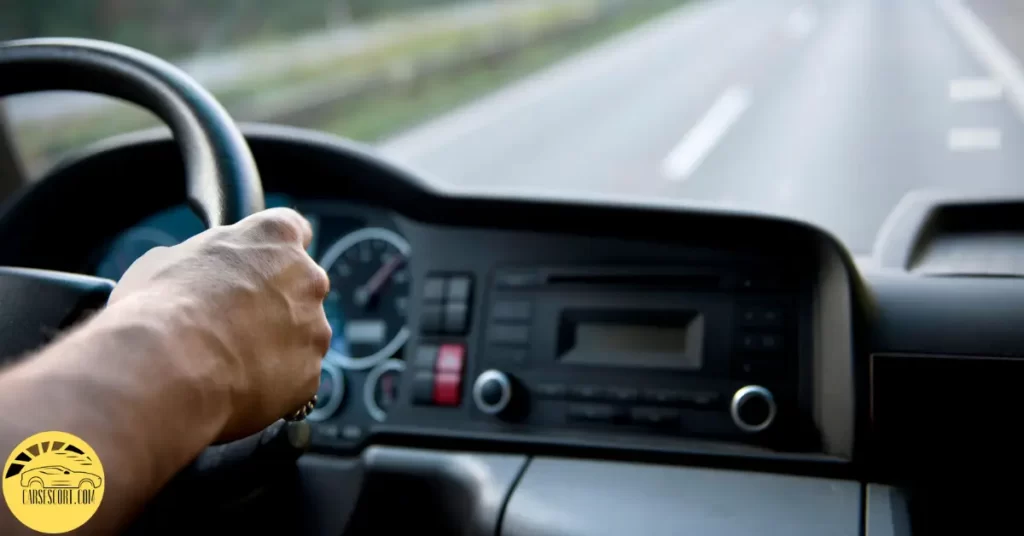
Why Does The Back End Of The Car Wobbles?
The back end of a car can wobble or shake because your car wheels are out of balance or out of alignment, which can cause vibrations that make the car feel unstable.
Another possible cause is worn or damaged suspension components, such as shocks or struts, which can lead to excessive movement in the rear of the vehicle.
A problem with the tires, such as low tire pressure in the back end tires or uneven wear, can also cause the car’s back end to wobble.
Why Does My Car Wobbles When Hitting Bumps?
The common cause of car wobbles is hitting bumps and worn suspension components, which can become less effective over time. Unbalanced tires or bent/damaged wheels can also cause this issue, as can loose or worn steering components.
FAQ
Is it safe to drive when your car is shaking?
No, it is not safe to drive when your car is shaking. A shaking car can indicate several potential problems, including tire, suspension, or engine troubles. These problems can affect your car’s stability, steering, and braking ability, making operating unsafe.
What causes the car’s front end to wobble?
Car front-end wobble can be caused by several factors, including unbalanced wheels, worn or damaged tires, loose or damaged suspension components, and worn or damaged brake components. Front-end wobble can make the steering feel loose or unresponsive and cause the vehicle to vibrate or shake while driving.
Can bad alignment cause wobble?
Yes, bad alignment can cause wobble. Improper wheel alignment can cause uneven tire wear, resulting in vibration or wobble in the steering wheel or vehicle.
Does a wheel bearing cause wobbling?
Yes, a wheel bearing can cause wobbling. A worn or damaged wheel bearing can cause the wheel to wobble or vibrate, particularly at higher speeds. Other signs of a failing wheel bearing include a humming or grinding noise from the wheel area, uneven tire wear, and steering or handling problems.
My Final Thoughts
Why car wobbles when driving? The primary reason for a car to wobble, shake or vibrate unevenly is due to problems with the tires and incorrect wheel alignment. Therefore, check the wheels and alignment of your vehicle first before exploring other potential causes.
This step can save you time and money. You can consider other solutions if the tires and alignment are in good condition.
Affiliate Disclosure: Cars Escort is a participant in the Amazon Services LLC Associates Program. As an Amazon Associate, we earn from qualifying purchases made through affiliate links on our site. Read Our Disclaimer .

